"The Process of Photosynthesis in Plants"
Photosynthesis is a process or proliferation of plants in converting light energy into chemical energy and storing it in the form of sugar bonds. Photosynthesis comes from the Greek language ie the photo is "light" and synthesis, which means "to compose". Photosynthesis does not only occur in plants but also organisms. Photosynthesis is the process by which plants and some organisms produce their own food using carbon dioxide, water and energy from sunlight.
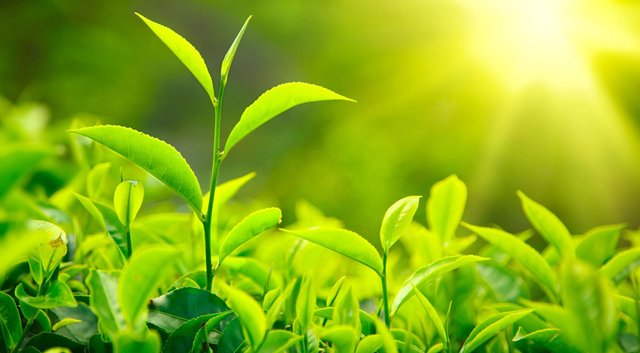
The Invention of Photosynthesis
Photosynthesis is the process by which plants and some other living organisms derive energy from sources-usually sunlight. Although this important process has existed since the beginning of time, everyone is fully aware of its existence, and it was not discovered until the 1800s. Several different scientists over a period of more than 200 years contributed to the discovery of natural phenomena about this photosynthesis.
The figures who discovered the process of photosynthesis:
Photosynthesis was found partly in the 1600s by Jan Baptista van Helmont, a Belgian chemist, physiologist and physician. Helmont conducted a 5-year experiment involving willow trees that he planted in pots with soil and placed in a controlled environment. The willow tree is carefully and precisely watered over a 5 year period. At the end of his experiment Helmont concluded that tree growth was the result of nutrients that had been received from water. Helmont's conclusion is accurate but his experiments prove that water contributes to plant growth.
Joseph Priestley is another scientist who contributes to the discovery of photosynthesis. ILahir in 1733 and later became a chemist, minister, natural philosopher, educator and political theorist. His experiments included putting the candle burning in a closed jar. Then in 1774, Priestley's experimental results were published in "Experiments and Observations of Different Kinds of Water, Volume I." Although Priestley did not know at the time, experiments proved that air contained oxygen.
Jan Ingenhousz, another scientist who contributed to the discovery of photosynthesis. He was a Dutch chemist, biologist and physiologist who conducted important experiments in the late 1770s that proved that plants produce oxygen. Ingenhousz placed submerged plants in sunlight and then in the shade. He realized that small bubbles are produced by plants when they are in the sun. When they are moved to a color bubble that is no longer produced by this plant. Ingenhousz then concluded that plants use light to produce oxygen.
In 1796, Jean Senebier, a Swiss botanist, pastor and naturalist showed that plants absorb carbon dioxide and release oxygen with the help of sunlight. In the early 1800s Nicolas-Theodore de Saussure showed that while plants need carbon dioxide, a growing increase in plant mass is not the result of carbon dioxide alone but also the absorption of water.
In the 1840s Julius Robert Mayer, a German physician and physicist, stated that energy can not be created or destroyed. This is known as the first law of thermodynamics. He proposed that plants convert light energy into chemical energy.
From 1862-1864 Julius Sachs investigated how starch is produced under the influence of light and in relation to chlorophyll. This eventually led to him writing a general equation for photosynthesis (6CO2 + 6H2O2 → (with light energy) C6H12O6 + 6O2 /).

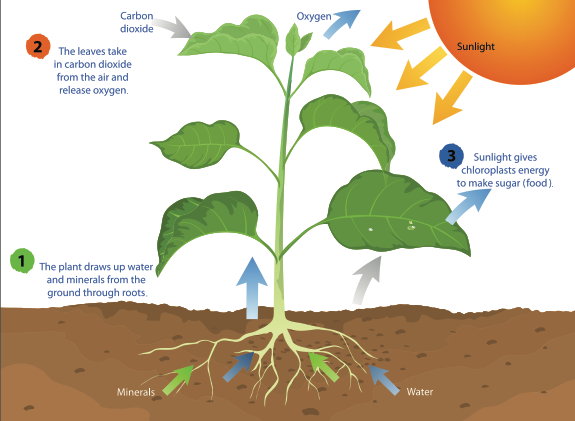

In the picture above can be explained that carbon dioxide added with water then processed with light energy to produce glucose, oxygen and water. Or can be explained by Six molecules of carbon dioxide and twelve water molecules, consumed, then produce glucose, six oxygen molecules and six water molecules.
Photosynthesis is a process whereby green plants and some algae (Kingdom of Protista), algae and some forms of bacteria make carbohydrates from carbon dioxide, water and inorganic salts, in the presence of chlorophyll, using light energy captured from the sun. Planting itself only needs light energy, CO2, and H2O in forming sugar. The process of photosynthesis occurs in chloroplasts, specifically using chlorophyll, chlorophyll is a leaf green pigment involved in the process of photosynthesis.
The above equation shows that water is a reactant and a product of photosynthesis. Because of the twelve water molecules consumed and the six water molecules produced, the equation can be simplified as shown below which is the formula of photosynthesis.


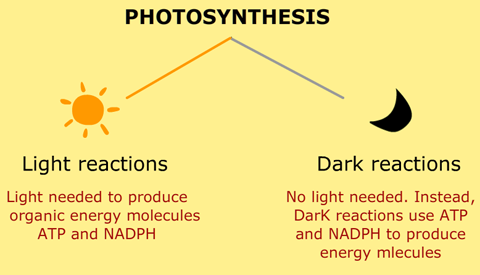

1). Reaction depends on light (light)
The first stage of photosynthesis is a light dependent reaction. This reaction takes place on the thylakoid membrane in the chloroplast. During this stage light energy is converted into ATP (chemical energy) and NADPH (reducing power).
Light is absorbed by two photosystems called photosystem I and photosystem II. This complex protein contains light molecules of chlorophyll and accessory pigments called complex antennas. Photosystem also comes with a central reaction. These are complex proteins and pigments that are responsible for energy conversion. Chlorophyll a in the photosystem I molecule absorbs light with a peak wavelength of 700 nm and is called the P700 molecule. Chlorophyll a photosystem molecule II absorbs light with a peak wavelength of 68O nm and is called the P68O molecule.
Light dependent reactions begin in photosystem II. When a light photon is absorbed by a chlorophyll molecule (P68O) at the center of the photosystem II reaction, an electron in a P68O molecule becomes higher than energy. The electrons become unstable and released and are transferred from one molecule of P68O to another in the electron-carrying chain called the electron transport chain (ETC). The P68O molecule becomes positively charged at the loss of electrons.
The lost electrons are replaced by the separation of water by light in the process called photolysis. Water is used as an electron donor in oxygenic photosynthesis and divided into electrons (e), hydrogen ions (H +, protons) and oxygen (O2). Hydrogen ions are brought to ATP and used to provide the energy needed to combine ADP to generate ATP. Oxygen is released into the air as a by-product of photosynthesis.
The process by which ATP is made using solar energy is called Photophosphorylation. This type of phosphorylation is used by plants and Cyanobacteria is called non-cyclic photophosphorylation. This is not just photosystem II, but also photosystem I.
Electrons from photosystem II are forwarded to the cytochrome b6-f complex and to photosystem I. Again, receiving energy from light photons is absorbed by chlorophyll molecules (P700). Electrons are carried by the electron transport chain (ETC) to the NADP reductase, which is the last electron acceptor. At this point the energy used to produce NADPH.
2). The reaction is independent of light (dark)
The second stage of photosynthesis is a light-independent reaction.
Another name often given for this reaction is the Calvin-Benson Cycle. This happens in the stroma of the chloroplast. During this time the reaction energy from ATP and NADPH is used to convert carbon dioxide into carbohydrates like glucose.
One molecule of carbon dioxide reacts with a 5-carbon sugar called ribulose bisphosphate (RuBP). This reaction produces a stable carbon 6 sugar which is immediately broken down to form two 3-carbon sugars known as 3 phosphoglycerate (3PGA).
3 phosphoglycerate sugars converted to glyceraldehyde 3 phosphate (G3P) using energy from ATP and reducing power from NADPH. Most of the resulting G3P is used to create RuBP which is then used to start the Calvin-Benson cycle again. Some G3P, however, are used to make glucose in plants used as an energy source.

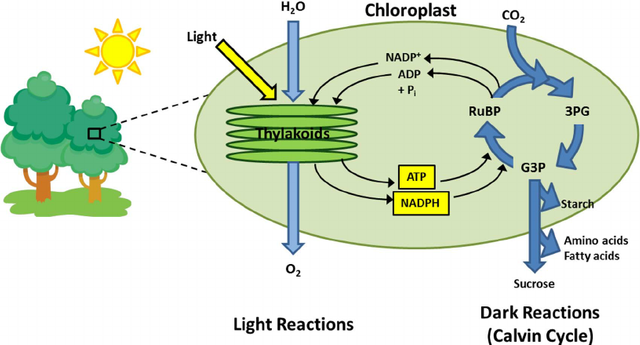

Types of Photosynthesis Process
There are two types of photosynthesis processes namely oxygenic photosynthesis and anoxygenic photosynthesis.
Oxygenic photosynthesis - Oxygenic photosynthesis is the most common and visible in plants, algae and cyanobacteria. During oxygenic photosynthesis, light transfers electron energy from water (H2O) to carbon dioxide (CO2), which produces carbohydrates. In this transfer, CO2 is "reduced," or accepts electrons, and water becomes "oxidized," or loses electrons. Ultimately, oxygen is produced together with carbohydrates. The function of oxygenic photosynthesis as a respiration counterpart, is required in the carbon dioxide produced by all breathing organisms and given back in the form of oxygen to the air. In his 1998 article, "An Introduction to Photosynthesis and Its Applications," Wim Vermaas, a professor at Arizona State University suspects, "without oxygenic photosynthesis, the oxygen in the air will run out within a few thousand years."
Anoxygenic photosynthesis - On the other hand, anoxygenic photosynthesis uses electron donors other than water. This process usually occurs in bacteria such as purple bacteria and green sulfur bacteria. Anoxigenic photosynthesis does not produce oxygen, so says David Baum, professor of botany at the University of Wisconsin Madison. What is produced depends on the electron donor. For example, many bacteria use a smelly egg gas that is hydrogen sulfide and sulfur producing solids as a by-product.

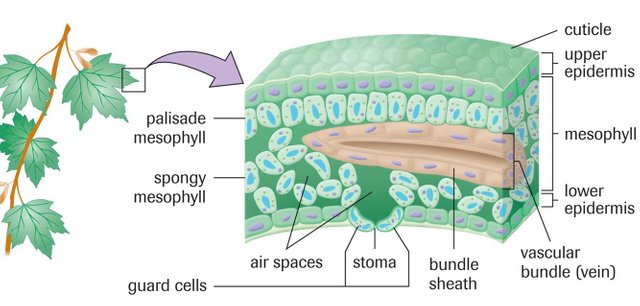

Leaf Plants Structure
Leaves have a characteristic covering the following. The upper and lower epidermis, the upper epidermis is the outer layer of the cell that reduces the amount of water lost through transpiration by the leaf plant. The lower epidermis contains stomata. the function of stomata in this leaf is the pores (holes) that are in the leaves which are responsible for the exchange of gas between the leaves and the atmosphere. Carbon dioxide is absorbed from the air and oxygen is released. Mesophyll, these are the parenchyma tissue cells located between the upper and lower epidermis. These cells contain chloroplasts.
Bonding vessels, these vascular bundles are the tissues that form part of the plant transport system. The bundle of vessels consists of xylem and phloem tissues that transport water, dissolved minerals and food to and from the leaves. The process of photosynthesis, photosynthesis in plants occurs in two stages. This stage is known as a dependent light reaction (light) and an independent light reaction (dark)
Leaf section
Leaves are very important for the growth and growth of plants.
Most of the reactions involved in the process of photosynthesis take place in the leaves. Leaf parts in the process of photosynthesis will take place mainly on the leaves of plants, and little can occur in the stem, and others.
Part of the leaves typical in photosynthesis include the upper and lower epidermis, mesophyll, vascular bundle (vein), and stomata.
The upper and lower epidermal cells have no chloroplasts, so photosynthesis does not occur there. They function mainly as a protection for the rest of the leaves.
The stomata hole has a function mainly on the lower epidermis and as an air exchange, which enters CO2 and O2 out.
Leaf-vessel bonds are part of the plant transport system, moving water and channeling nutrients. The mesophyll cells have chloroplasts and this is the place where photosynthesis occurs.



Mobile components are important for photosynthesis
- Pigments - Pigments are molecules that give color to plants, algae and bacteria, but they are also responsible for effectively for trapping sunlight. Pigments of different colors absorb different wavelengths of light.
Here are three main groups.
Chlorophyll - Green pigments are able to trap blue and red light. Chlorophyll has three sub-types, dubbed chlorophyll a, chlorophyll b and chlorophyll c. According to Eugene Rabinowitch and Govindjee in their book "Photosynthesis" (Wiley, 1969) chlorophyll is found in all photosynthesizing plants. There is also a bacterial variant called bacteriochlorophyll, which absorbs infrared light. These pigments are primarily seen in the purple and green color of bacteria, which perform anoxygenic photosynthesis.
Carotenoids - these red, orange, or yellow colored pigments absorb the bluish green light. Examples of carotenoids are xantofil (yellow) and carotene (orange) which carrots get their color.
Phycobilins - Red or blue pigments absorb the wavelength of light that is not also absorbed by chlorophyll and carotenoids. They are seen in cyanobacteria and red algae.
Plastids - Photosynthetic eukaryotic organisms contain organelles called plastids in their cytoplasm. According to Cheong Xin Chan and Debashish Bhattacharya of Rutgers University (Natural Education, 2010), double plastid membranes in plants and algae are referred to as primary plastids, while various multi-membranes are found in plankton called secondary plastids. These organelles generally contain pigments or can store nutrients. (read: plastid function in plants)
Chloroplasts - Chloroplasts are the parts that are on the outer and inner membranes, the space between the membranes, stromata, and tilakoid stacked. Chlorophyll is built into the membrane of the thylakoid. Chlorophyll looks green because it absorbs red and blue light, making these colors invisible to our eyes. Unabsorbed green light eventually reaches our eyes, making the chlorophyll appear green. However, it is the energy of the absorbed red and blue light that is, so it can be used to perform photosynthesis. Chloroplasts are similar to mitochondria that they have their own genome, or a collection of genes, contained in DNA. This gene encodes important proteins for organelles and for photosynthesis. Like mitochondria, chloroplasts are also thought to originate from primitive bacterial cells through an endosymbiosis process.
Antenna - Antenna is a protein-related pigment molecule, which allows them to have the flexibility to move toward light and against each other. This structure effectively captures the energy of light from the sun, in the form of photons. Ultimately, the light energy must be transferred to a complex protein pigment that can convert it into chemical energy, in the form of electrons. In plants, for example, light energy is transferred to the chlorophyll pigment. Conversion to chemical energy is done when the chlorophyll pigment expels the electrons, which can then proceed to the right receiver.

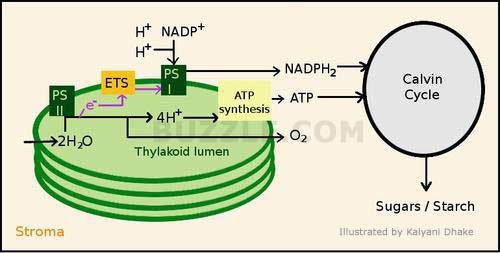

Role of Photolisis
Using light to separate water becomes as follows.
Electrons, donated to photosystem II in replacing lost electrons
Hydrogen ion, brought to the synthesis of ATP to provide energy in the production of ATP
Oxygen, released into the air as a product
The resulting product
ATP is a chemical energy
NADPH to reduce power or electron donors

This is my writing in the form of chemistry that tells the science of chemistry entitled "The Process of Photosynthesis in Plants". my writing on photosynthesis is not yet perfect and I think it is clear, so I will continue on to my next writing to discuss about this photosynthesis. thanks for those who have read. suggestions and criticism I really hope if it is necessary, comment wisely and let me know if there is a mistake in my writing this.



The article was very much helpful to me.
Congratulations! This post has been upvoted from the communal account, @minnowsupport, by manah from the Minnow Support Project. It's a witness project run by aggroed, ausbitbank, teamsteem, theprophet0, someguy123, neoxian, followbtcnews/crimsonclad, and netuoso. The goal is to help Steemit grow by supporting Minnows and creating a social network. Please find us in the Peace, Abundance, and Liberty Network (PALnet) Discord Channel. It's a completely public and open space to all members of the Steemit community who voluntarily choose to be there.
Resteemed your article. This article was resteemed because you are part of the New Steemians project. You can learn more about it here: https://steemit.com/introduceyourself/@gaman/new-steemians-project-launch
I will link to your article on my latest article regarding food production on Mars. I followed you because the article is an actual gem. I didn't have time to browse through your articles but I will read more of your articles if you are still active. You are doing a good job! Don't forget to check @SteemSTEM if you didn't already! Cheers and let me know if i can help you in some way! Cheers!